Tourism And Attractions In Cuba offer a vibrant blend of history, culture, and natural beauty, making it a captivating destination for travelers. SIXT.VN can help you explore this Caribbean gem with ease and convenience, providing services like airport transfers, hotel bookings, and guided tours. Discover the best Cuba has to offer, from Havana’s historic streets to Varadero’s stunning beaches, and let SIXT.VN take care of the details. Whether you are looking for cultural excursions or beach escapes, Cuba promises an unforgettable experience.
1. What Makes Old Havana (Habana Vieja) A Must-Visit?
Old Havana, or Habana Vieja, is a UNESCO World Heritage site and a living museum of Cuban history. As you wander through its cobbled streets, surrounded by Baroque and neoclassical buildings, you’ll feel transported back in time.
The ongoing renovations are revitalizing the historic architecture, adding to the charm of this district. Key attractions include:
- Plaza de la Catedral: Home to the stunning Cuban Baroque Catedral de San Cristobal.
- Bodeguita del Medio: The legendary restaurant and former haunt of Ernest Hemingway.
- Castillo de la Real Fuerza: A historic military fortress.
- Plaza Vieja: A vibrant square featuring notable buildings like the 18th-century Casa del Conde Jaruco.
Exploring Old Havana on foot is the best way to appreciate its character, with photo opportunities around every corner. Consider dining at paladars, family-owned restaurants, and staying at casas particulares for an authentic experience.
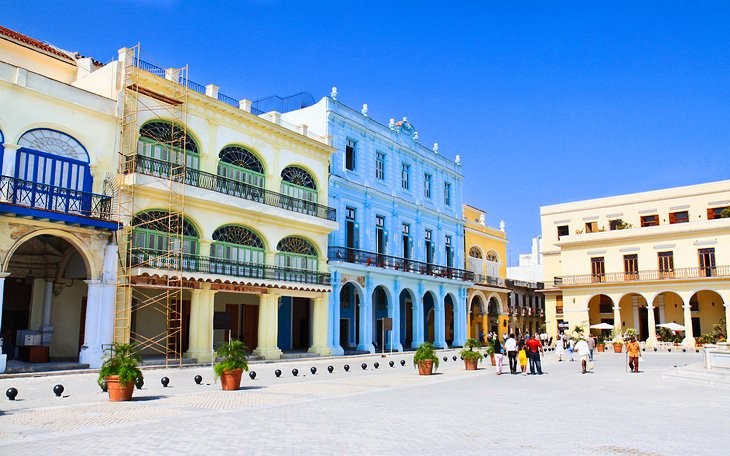 Plaza Vieja in Old Havana, Cuba, featuring colorful colonial architecture and vintage cars
Plaza Vieja in Old Havana, Cuba, featuring colorful colonial architecture and vintage cars
2. Why Is Varadero Considered One Of Cuba’s Premier Beach Destinations?
Varadero is renowned as one of Cuba’s top beach destinations, boasting some of the most beautiful beaches in the Caribbean. Stretching along the Peninsula de Hicacos, Varadero offers a paradise of white-sand beaches and crystal-clear waters.
With over 50 beach resorts lining the coast, visitors can enjoy a range of activities and attractions:
- Parque Ecológico Varahicacos: Explore natural caves like Cueva de Ambrosio and Cueva de Musulmanes.
- Saturno Cave (Cueva de Saturno): Take a refreshing dip in this stunning cenote.
- Parque Josone: Relax in lush flower gardens and enjoy the serene lake.
Besides diving and snorkeling, popular activities in Varadero include deep-sea fishing, golfing, skydiving, and cultural day trips. According to a 2022 report by the Cuban Ministry of Tourism, Varadero welcomed over 1.2 million tourists, underscoring its popularity.
3. How Does Trinidad Offer A Step Back In Time?
Trinidad, a UNESCO World Heritage Site, offers a unique glimpse into Cuba’s colonial past. The city’s well-preserved buildings and cobblestone streets transport you to the 17th to 19th centuries, a period when Trinidad thrived from the sugar and slave trades.
Key attractions in Trinidad include:
- Plaza Mayor: The city’s central square, bustling with vibrant life.
- Church of the Holy Trinity (Iglesia Parroquial de la Santisima Trinidad): A neoclassical landmark overlooking the square.
- Church and Monastery of Saint Francis (Iglesia y Convento de San Francisco): Known for its distinctive bell tower.
- Palacio Brunet: A grand home built in 1812, featuring original frescoes and marble floors.
The nearby Valle de los Ingenios, also a World Heritage Site, showcases relics and monuments from the 19th-century sugar cane plantations.
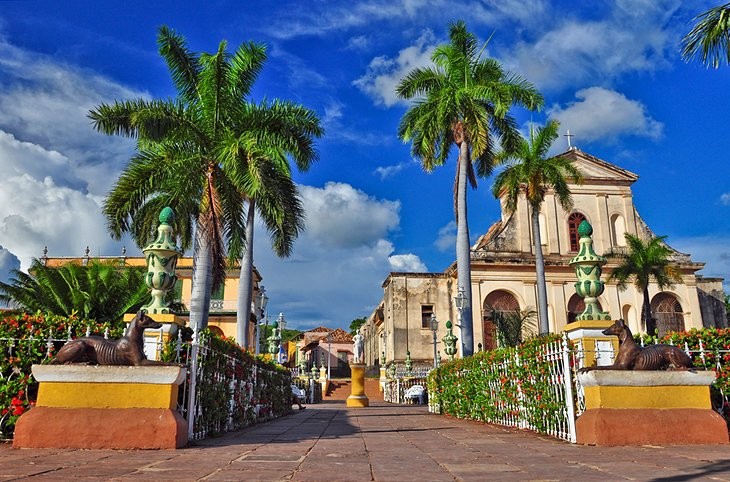 Cobblestone streets and colonial architecture in Trinidad, Cuba, under a clear sky
Cobblestone streets and colonial architecture in Trinidad, Cuba, under a clear sky
4. What Makes Guardalavaca A Unique Beach Destination In Cuba?
Guardalavaca, located in the Holguin province, offers a more tranquil and remote beach experience compared to Varadero. Its lush foliage, pristine beaches, and vibrant coral reefs make it a haven for relaxation and exploration.
Visitors can enjoy:
- Glittering beaches: Perfect for swimming and sunbathing.
- Diving and snorkeling: Explore the diverse marine life along the coral reefs.
- Day trips: Including jungle adventures, sailing trips, and sightseeing tours to Santiago de Cuba.
Bahia de Naranjo, west of Guardalavaca, features Cayo Naranjo and the popular Dolphinarium. Chorro de Maita offers a glimpse into native Indian history with its burial area and recreated Taino Indian village.
5. Why Is Playa Paraíso On Cayo Largo del Sur Considered One Of Cuba’s Best Beaches?
Playa Paraíso, located on the island of Cayo Largo del Sur, is celebrated as one of Cuba’s most stunning beaches. Its powdery white sand and crystal-clear turquoise waters offer a quintessential paradise experience.
Cayo Largo del Sur is known for its dry, sunny climate and pristine beaches, making it a top destination for sun-seekers. Playa Sirena, equally captivating, merges with Playa Paraíso, providing an extended stretch of natural beauty.
Sections of these beaches are clothing-optional, adding to the relaxed and自由氛围. According to TripAdvisor, Playa Paraíso consistently ranks as one of the top beaches in the world, attracting visitors seeking tranquility and natural beauty.
6. How Does Cayo Coco Combine Beach Bliss And Natural Beauty?
Cayo Coco is another idyllic beach destination in Cuba, offering a blend of pristine beaches and isolated charm. Part of the Jardines del Rey archipelago, Cayo Coco is connected to the mainland by a bridge, though air travel is more common.
Key attractions include:
- Playa Los Flamencos: A five-kilometer stretch of sun-bleached sand on the Atlantic side.
- Playa Prohibida: A quiet, undeveloped beach with a peaceful nature trail.
- Excellent birding opportunities: The island is known for its diverse birdlife.
Connected to Cayo Coco by a causeway, Cayo Guillermo features beautiful beaches like Playa Pilar and a range of all-inclusive resorts.
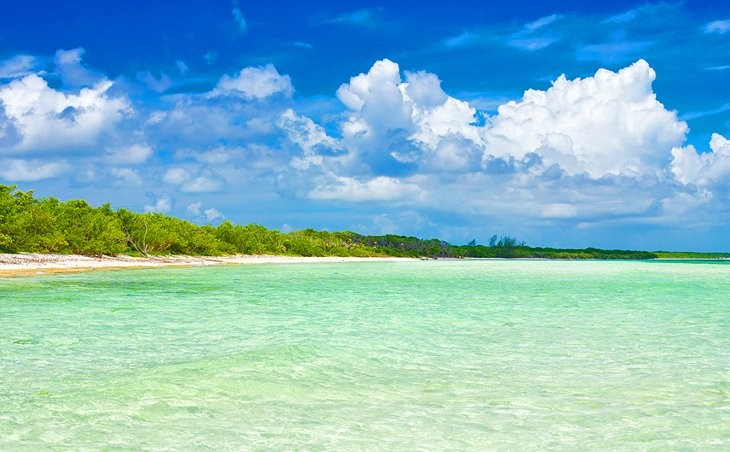 Turquoise waters and white sand beaches of Cayo Coco, Cuba, under a bright sky
Turquoise waters and white sand beaches of Cayo Coco, Cuba, under a bright sky
7. What Makes Parque Nacional Viñales (Valle de Viñales) A Unique Landscape?
Parque Nacional Viñales, a UNESCO World Heritage Site, is a lush valley in the Sierra de los Organos, known for its dramatic landscape. Steep limestone hills, called mogotes, rise from the valley floor, creating a visually stunning area.
The valley floors are agricultural areas where tobacco, fruits, and vegetables are grown. Outdoor enthusiasts can enjoy:
- Hiking and horseback riding: Explore the hills and scenic trails.
- Coffee plantation tours: Learn about local coffee production.
- Cave exploration: Discover hidden underground wonders.
- Rock climbing and ziplining: For the adventurous traveler.
The nearby town of Viñales serves as a great base for exploring the park, with day trips available from Havana.
8. How Does Baracoa Stand Out As A Historic And Natural Gem In Cuba?
Baracoa, the oldest city in Cuba, founded in 1511, is a highlight of the island’s eastern region. Cut off from the outside world until the 1960s, Baracoa retains a remote and charming feel, blending colonial architecture with lush natural landscapes.
Key attractions include:
- El Yunque: A flat-topped peak offering guided hikes to its 589-meter summit.
- La Farola highway: A winding road providing spectacular scenery over the mountains.
- Museo Municipal: Housed in the Fuerte Matachin fortress, offering insights into Baracoa’s history.
- Playa Maguana: A picture-perfect beach located about 20 kilometers northwest of Baracoa.
Flights to Baracoa depart frequently from Havana, making it accessible for travelers.
9. What Is The Significance Of The Malecon In Havana?
The Malecon, Havana’s famous seafront promenade, is a stroll through the city’s history. Conceived in 1901, this seven-kilometer stretch runs from Habana Vieja to Vedado, the central business district.
Along the Malecon, you’ll find well-preserved 20th-century buildings representing a mix of architectural styles, including Art Deco and Neo Moorish. Painted in pastel colors, these buildings are a delight for photographers, especially at dusk.
People-watching is a popular activity, with young lovers, fishermen, and children enjoying the vibrant atmosphere. The Malecon is also a hub for cultural events and live music, enhancing its appeal.
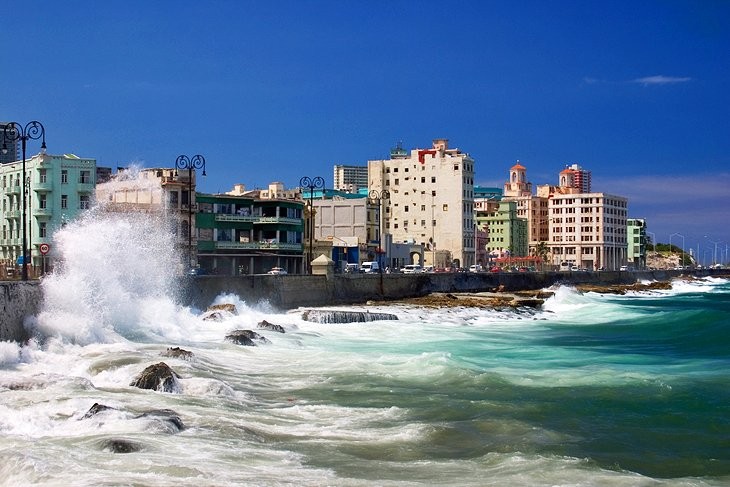 Pastel-colored buildings lining the Malecon in Havana, Cuba, with vintage cars in the foreground
Pastel-colored buildings lining the Malecon in Havana, Cuba, with vintage cars in the foreground
10. Why Is The Che Guevara Mausoleum In Santa Clara A Place Of Historical Importance?
The Che Guevara Mausoleum in Santa Clara is a site of significant historical importance, marking the location of Che Guevara’s last guerrilla battle in 1958. His remains are laid to rest here, making it a pilgrimage site for those interested in Cuban history.
Key attractions include:
- Mausoleo del Che Guevara: The mausoleum where Che Guevara’s remains are interred.
- Memorial Comandante Ernesto “Che” Guevara: A monument featuring a bronze statue of Che Guevara.
- Museo Historico de la Revolucion: Exhibits Che Guevara’s personal items.
- Monumento a la Toma del Tren Blindado: A small boxcar museum commemorating the final battle.
Santa Clara offers a deeper understanding of Cuba’s revolutionary history, complementing the beach towns and resorts.
11. What Treasures Await Art Lovers At The Museo Nacional De Bellas Artes?
The Museo Nacional de Bellas Artes in Havana is a must-visit for art enthusiasts, housing a vast and impressive collection of international and Cuban art. The collection spans from ancient times to the present day and is displayed in two buildings.
- Palacio del Centro Asturiano: Displays international art, including works by European Masters, ancient art from Greece, Rome, and Egypt, and works from Asia, the United States, and Latin America.
- Palacio de Bellas Artes: Showcases Cuban Art from the 17th century to the present day, including sculptures, prints, and paintings.
The museum offers a comprehensive overview of Cuban and international art history, making it a cultural highlight in Havana.
12. What History Is Encapsulated At Castillo De San Pedro Del Morro, Santiago De Cuba?
Castillo de San Pedro del Morro, a UNESCO World Heritage Site, is one of the best-preserved Spanish fortresses from the 17th century. Located at the entrance to the Bay of Santiago, it offers a glimpse into Cuba’s colonial military history.
Originally designed to protect against pirate attacks, the fort also served as a prison in the late 1700s. Today, visitors can explore the different levels of the fort, learn about its history in the small museum, and enjoy impressive views over the bay.
Other cultural highlights in Santiago de Cuba include the Diego Velazquez Museum and Cementerio de Santa Ifigenia, where some of Cuba’s most famous military figures are buried.
13. How Does Peninsula De Zapata (Ciénaga De Zapata) Offer A Unique Natural Experience?
Peninsula de Zapata, also known as Ciénaga de Zapata, is a remote area with diverse landscapes and one of the largest wetlands in the Caribbean. It is a UNESCO Biosphere Reserve and a haven for birders and nature lovers.
Key attractions include:
- Gran Parque Natural de Montemar: A nature reserve where you can see various bird species and crocodiles.
- Playa Giron: The site of the 1961 Bay of Pigs Invasion, with a small museum detailing the events.
- Playa Larga: A long beach backed by lush vegetation, offering excellent diving sites.
- Criadero de Cocodrilos: A crocodile farm in Boca de Guama.
The Peninsula de Zapata offers a unique opportunity to experience Cuba’s natural beauty and wildlife.
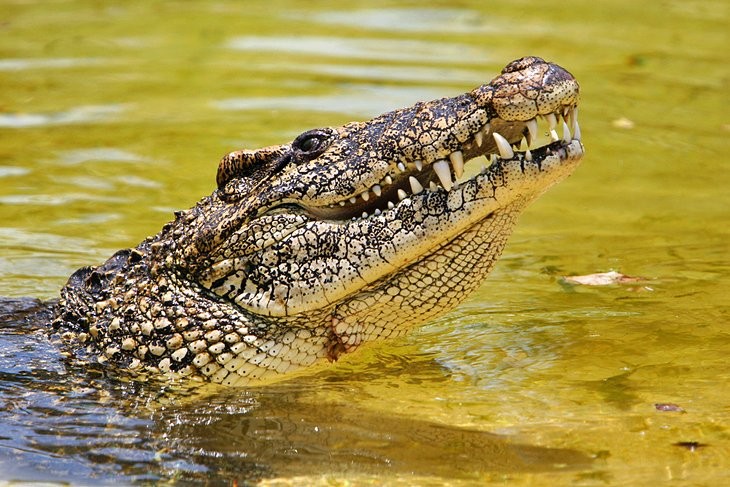 Swampy landscape of Peninsula de Zapata, Cuba, with lush vegetation and open water
Swampy landscape of Peninsula de Zapata, Cuba, with lush vegetation and open water
14. Why Are El Nicho Waterfalls A Must-See Natural Wonder In Central Cuba?
El Nicho Waterfalls, located in Parque El Nicho, are a ravishing slice of nature in central Cuba. About a 90-minute drive from Trinidad or Cienfuegos, these multi-tiered falls flow into jade-green jungle pools, offering a perfect spot for a refreshing dip.
The drive to El Nicho is an adventure in itself, with beautiful scenery along the twisty roads. Once you arrive, a 1.5-mile palm-lined trail leads to the park’s most scenic spots, where you can swim and sunbathe.
Along the way, keep an eye out for the tocororo, Cuba’s national bird, and the royal palm. A scenic lookout offers breathtaking views across lush valleys.
15. How Does Parque Historico Militar In Havana Showcase Cuba’s Military History?
The Parque Historico Militar encompasses two of Havana’s famous fortresses: the Castillo de los Tres Reyes del Morro (El Morro) and Fortaleza de San Carlos de la Cabana.
- El Morro: Built in the late 16th century and early 17th century, it offers impressive views of the ocean and city.
- Fortaleza de San Carlos de la Cabana: Constructed in the 1770s, it was the largest fort the Spanish ever built.
The most popular time to visit is at night when actors dressed in 19th-century costumes perform Ceremonia del Cañonazo, a cannon-firing ceremony, at 9 pm.
16. What Significance Does Plaza De La Revolucion (Jose Marti Memorial) Hold In Havana’s History?
Plaza de la Revolucion, home to the Jose Marti Memorial, holds an important place in Havana’s history. Castro delivered speeches in this vast square, attracting over a million people at times.
In the center of the square stands a 109-meter gray tower, a memorial to the Cuban national hero, Jose Marti. Below the statue is the entrance to the Jose Marti Memorial, which contains a museum. Ascend the tower for incredible views over Havana.
Opposite the memorial, the famous giant portrait of Che Guevara adorns the Ministry of Interior building.
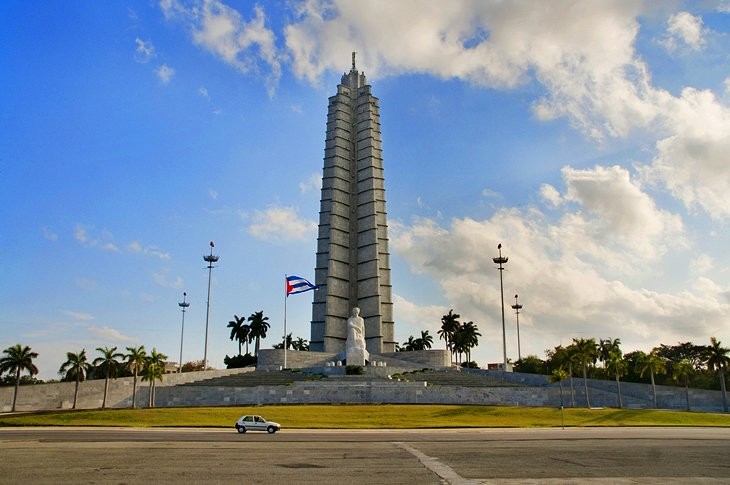 Overview of Plaza de la Revolucion in Havana, Cuba, with the Jose Marti Memorial and surrounding buildings
Overview of Plaza de la Revolucion in Havana, Cuba, with the Jose Marti Memorial and surrounding buildings
17. What Makes Fusterlandia A Unique Artistic Experience In Havana?
Fusterlandia, also known as Jaimanitas, is a neighborhood transformed by local artist José Fuster, often called the Picasso of the Caribbean. Mosaics, paintings, and sculptures in every color of the rainbow decorate this small neighborhood, creating a riot of color and artistic inspiration.
Fuster’s home studio is a must-see, and many Havana tours include a visit to this famous neighborhood. The hop-on, hop-off tourist bus and classic car tours are also available for exploring Fusterlandia.
18. How Can SIXT.VN Enhance Your Travel Experience In Cuba?
Planning a trip to Cuba can be exciting, but it also comes with its challenges. From arranging airport transfers and accommodations to navigating local transportation and booking tours, the logistics can be overwhelming. This is where SIXT.VN steps in to make your travel experience seamless and enjoyable.
SIXT.VN offers a range of services designed to cater to every traveler’s needs:
18.1. Airport Transfers
Arriving in a new country can be stressful, especially when you have to worry about finding reliable transportation to your hotel. SIXT.VN provides airport transfer services that ensure a smooth and hassle-free journey from the airport to your accommodation.
- Convenience: Pre-book your airport transfer and avoid long taxi queues or the uncertainty of public transportation.
- Reliability: SIXT.VN partners with trusted local transportation providers to guarantee timely and dependable service.
- Comfort: Travel in comfort with well-maintained vehicles and professional drivers.
18.2. Hotel Bookings
Finding the perfect hotel that fits your budget and preferences can be time-consuming. SIXT.VN simplifies this process by offering a wide selection of hotels in Cuba, from luxury resorts to budget-friendly options.
- Variety: Choose from a diverse range of hotels in popular destinations like Havana, Varadero, and Trinidad.
- Best Prices: SIXT.VN negotiates with hotels to offer you the best possible rates.
- Easy Booking: Use SIXT.VN’s user-friendly platform to compare hotels, read reviews, and book your stay with ease.
18.3. Guided Tours
Exploring Cuba’s rich culture and history is best done with a knowledgeable guide. SIXT.VN offers a variety of guided tours that cater to different interests.
- Expert Guides: Learn about Cuba’s history, culture, and traditions from experienced local guides.
- Customized Itineraries: Choose from pre-designed tours or create a customized itinerary to suit your interests.
- Hassle-Free Experience: Let SIXT.VN take care of the logistics, so you can focus on enjoying your tour.
18.4. 24/7 Support
SIXT.VN understands that travel plans can change, and unexpected issues can arise. That’s why they offer 24/7 customer support to assist you with any questions or concerns.
- Availability: Contact SIXT.VN’s support team anytime, day or night, for assistance.
- Multilingual Support: Get help in your preferred language.
- Peace of Mind: Travel with the confidence that SIXT.VN is there to support you every step of the way.
By choosing SIXT.VN, you can eliminate the stress of planning your trip to Cuba and enjoy a seamless and unforgettable travel experience. From airport transfers and hotel bookings to guided tours and 24/7 support, SIXT.VN has everything you need to make your Cuban adventure a success.
Ready to experience the best of Cuba without the hassle? Visit SIXT.VN today and start planning your dream vacation!
FAQ About Tourism And Attractions In Cuba
- What are the best times to visit Cuba?
- The best time to visit Cuba is during the dry season, from November to April, when the weather is pleasant and there is less rainfall.
- Do I need a visa to travel to Cuba?
- Most nationalities require a tourist visa to enter Cuba. Check the specific requirements based on your citizenship before traveling.
- What currency is used in Cuba?
- Cuba has two currencies: the Cuban Peso (CUP) and the US dollar (USD). Tourists primarily use the USD.
- Is it safe to travel to Cuba?
- Cuba is generally considered a safe destination for tourists, with low crime rates. However, it’s always wise to take standard safety precautions.
- What should I pack for a trip to Cuba?
- Pack light, breathable clothing, comfortable walking shoes, sunscreen, insect repellent, and any necessary medications.
- Can I use credit cards in Cuba?
- Credit card acceptance is limited in Cuba, so it’s best to bring cash for most transactions.
- What are some cultural etiquette tips for visiting Cuba?
- Dress modestly when visiting religious sites, be respectful of local customs, and learn a few basic Spanish phrases.
- Are there any health precautions I should take before traveling to Cuba?
- Consult your doctor about recommended vaccinations and health precautions before your trip.
- How can I get around in Cuba?
- Options include taxis, buses, rental cars, and local transportation. Taxis are readily available in major cities.
- What are some popular Cuban dishes I should try?
- Try ropa vieja (shredded beef), arroz con pollo (rice with chicken), and Cuban sandwiches for a taste of local cuisine.
Address: 260 Cau Giay, Hanoi, Vietnam.
Hotline/Whatsapp: +84 986 244 358.
Website: SIXT.VN.



